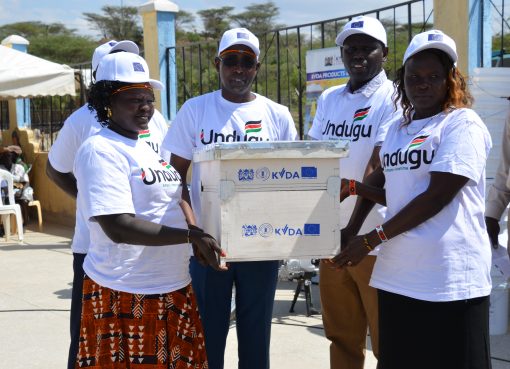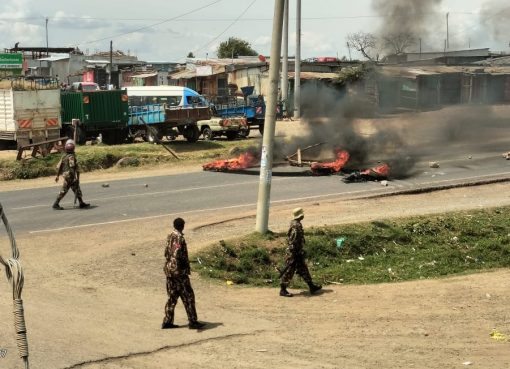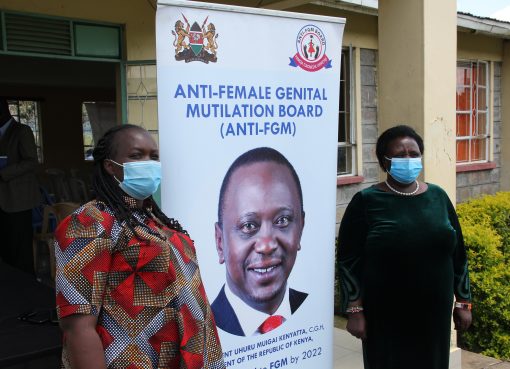According to the United Nations` International Children`s Emergency Fund (UNICEF), female genital mutilation (FGM) comprises all procedures that involve partial or total removal of the external female genitalia, or other injury to the female genital organs for non-medical reasons.
The practice is mostly carried out by traditional circumcisers, who often play other central roles in communities, such as attending childbirths. In many settings, health care providers perform FGM due to the erroneous belief that the procedure is safer when done by such professionals.
This is mostly true for communities that perform the vice under cover as such girls are normally hidden in a house or taken to hospital on pretext that they were unwell only for them to be cut and kept in hospital for a few more day before being discharged.
FGM is recognized internationally as a violation of the human rights of girls and women. It reflects deep-rooted inequality between the sexes, and constitutes an extreme form of discrimination against women.
It is nearly always carried out on minors and is a violation of the rights of children. The practice also violates a person’s rights to health, security and physical integrity, the right to be free from torture and cruel, inhuman or degrading treatment, and the right to life when the procedure results in death.
According to World Health Organization (WHO), the procedure has no health benefits for girls and women and could cause severe bleeding and problems urinating, and later cysts, infections, as well as complications in childbirth and increased risk of newborn death.
It involves removing and damaging healthy and normal female genital tissue, and interferes with the natural functions of girls’ and women’s bodies. Risks increase with increasing severity of the procedure.
Long-term consequences of FGM could include: urinary problems (painful urination, urinary tract infections); vaginal problems (discharge, itching, bacterial vaginosis) and other infections.
Other effects include menstrual problems (painful menstruations, difficulty in passing menstrual blood, etc.); scar tissue and keloid; sexual problems (pain during intercourse), decreased satisfaction, among others.
It also leads to increased risk of childbirth complications namely difficult delivery, excessive bleeding, caesarean section, need to resuscitate the baby and newborn deaths.
Someone who has undergone FGM may need later surgeries. For example, FGM procedure that seals or narrows a vaginal opening (type 3) needs to be cut open later to allow for sexual intercourse and childbirth (de-infibulation). Sometimes, genital tissue is stitched again several times, including after childbirth, hence the woman goes through repeated opening and closing procedures, further increasing both immediate and long-term risks;
Psychological problems include depression, anxiety, post-traumatic stress disorder, low self-esteem, among others.
More than 200 million girls and women alive today have been cut in 30 countries in Africa, the Middle East and Asia where FGM is concentrated.
The practice is most common in the western, eastern, and north-eastern regions of Africa, in some countries the Middle East and Asia, as well as among migrants from these areas. FGM is therefore a global concern. More than 3 million girls are estimated to be at risk for FGM annually.
Female genital mutilation is classified into four major types. The first one is referred to as clitoridectomy which involves partial or total removal of the clitoris (a small, sensitive and erectile part of the female genitals), and in very rare cases, only the prepuce (the fold of skin surrounding the clitoris).
The other type according to UNICEF is referred to as excision which involves the partial or total removal of the clitoris and the labia minora (the inner folds of the vulva), with or without excision of the labia majora (the outer folds of skin of the vulva).
Then there is infibulation which involves the narrowing of the vaginal opening through the creation of a covering seal. The seal is formed by cutting and repositioning the labia minora, or labia majora, sometimes through stitching, with or without removal of the clitoris (clitoridectomy).
Type four, according to UNICEF, includes all other harmful procedures to the female genitalia for non-medical purposes, e.g. pricking, piercing, incising, scraping and cauterizing the genital area.
The reasons why female genital mutilations are performed vary from one region to another as well as over time, and include a mix of sociocultural factors within families and communities.
First, where FGM is a social convention (social norm), the social pressure to conform to what others do and have been doing, as well as the need to be accepted socially and the fear of being rejected by the community, are strong motivations to perpetuate the practice. In some communities, FGM is almost universally performed and unquestioned.
The 2nd ‘End FGM’ conference held at Maasai Mara University last week was officially opened by the Cabinet Secretary for Public Service, Gender and Youth Prof. Margaret Kobia.
During the conference, a Maasai Community Peace Crusader, Mr. Joseph Pareiyo and a Pokot elder, Mr. Philip Lomoini told the conference that their communities practiced FGM to avoid stigma and gain acceptance in the community as women and girls who have not undergone the practice were normally frowned upon and rejected and therefore would never get married.
The Public Service, Gender and Youth Principal Secretary, Ms. Safina Kwekwe was in attendance for the two days to represent her Cabinet Secretary and follow deliberations on this important meeting whose resolutions will inform policy decisions in the government.
The two elders from Maasai and Pokot communities also said FGM was done to apparently reduce promiscuity among the women.
The Maasai communities being pastoralists for example mean that men will be way from the family for a long time and FGM was supposed to help keep the woman in check. It was aimed at ensuring premarital virginity and marital fidelity. FGM is in many communities believed to reduce a woman’s libido and therefore believed to help her resist extramarital sexual acts.
For some communities, when a vaginal opening is covered or narrowed (type 3), the fear of the pain of opening it, and the fear that this infidelity will be found out was expected to further discourage extramarital sexual intercourse among women with this type of FGM.
FGM is often considered a necessary part of raising a girl, and a way to prepare her for adulthood and marriage.
Though no religious scripts prescribe the practice, practitioners often believe the practice has religious support. This is true for both Christians and Muslims. But sadly, it’s the adherents of these faiths who are found to engage in FGM and use religion to justify their actions.
One may ask; why is FGM widespread in Kenya despite existing elaborate laws prohibiting the act?
Although the practice of FGM was outlawed in Kenya in 2001 under laws that prohibit customs harmful to children and Under the FGM Act, 2011, it is still rampant among the Kenyan communities.
The 2011 FGM Act stipulates that a person who commits an offence under this Act is liable, on conviction, to imprisonment for a term of not less than three years, or to a fine of not less than Sh200, 000, or both.
The Somali community is leading in propagating this medically harmful practice of the female cut by 94 per cent. They are closely followed by Samburu who practice FGM at a rate of 86 per cent.
The Abagusi and Maasai communities are third and fourth respectively with a prevalence of 84 and 78 per cent. Over 37 of the 42, now 44 tribal communities living in Kenya still practice Female Genital Mutilation.
The preferential age for the procedure used to be 15 years but now it’s done to those as young as eight where they are then married off. Despite a ban on it in 2011, more than 500 girls in Narok County drop out of school every year because of Female Genital Mutilation and early marriages.
According to UNICEF, 9.3 million women and girls, or 27 per cent of all women and girls in Kenya have undergone genital mutilation, placing Kenya 17th among the 30 countries in Africa and the world that carry out the practice.
But new data from the 2014 Kenya Demographic Health Survey (KDHS) shows that 21 per cent or one in five Kenyan women and girls aged 15-49 have been circumcised, an 11 per cent drop from 11 years earlier.
There have been international efforts since the 1970s to persuade practitioners to abandon FGM, and it has been outlawed or restricted in most of the countries in which it occurs, although the laws are poorly enforced.
During the aforementioned 2nd FGM conference, law enforcers and prosecutors told the conference that enforcing the law on FGM in the affected areas is faced with various challenges.
Ms. Mercy Nyokabi, a State Counsel and Mr. Ronald Mwiwawi who is the Narok North Sub County Deputy County Commissioner told the meeting that the Maasai have devised a secretive way of performing the act in order to beat the law by doing it secretly at night. It’s worth noting that less than 15 cases of FGM nature have been filed before Narok Law Court since 2014 due to this secretive and uncooperative nature of the Maasai community on the matter.
They said even when found, it was difficult to get witnesses to come and testify in court as they see nothing wrong with the vice and therefore do not want to help in jailing the perpetrators who were mostly close relatives.
The Narok Senior Principal Magistrate, Tito Gesora on his part said in view of the foregoing, even the few cases that come to court do not come to conviction due to lack of evidence.
He at the same time advised law enforcers to consider charging those who circumcise girls with grievous harm instead of the Children Act 2006 which he said was a bit lenient on these offenders.
“The penal code gives a maximum sentence of life for grievous harm (where a part of the body is removed or cut off) but the Children’s Act (2006) gives a lenient fine of Sh.200, 000 or five years in jail for somebody found practicing Female Genital Mutilation (FGM),” he said.
How can we prevent FGM?
The conference resolved that the Kenya anti FGM board should be better funded so that it could take its services to the grassroots and empowered if we want to eradicate FGM by 2030.
Gesora on his part also recommended that report desks should be set up at police stations for reporting of FGM cases where the cases should also be handled by specially trained officers.
He also suggested that intelligence information should be gathered to be used in investigations and prosecutors and investigators in matters FGM should be trained and empowered to produce better physical and medical evidence in court for conviction to be attained in FGM cases.
The meeting also resolved that men and youth should be involved in the fight against FGM if it is to succeed as they were the key decision-makers in the homes an some decide that they would not marry an uncircumcised girl.
All in all, the war on FGM is a war that requires a multi-sectoral approach if it is to be won. To this end, Professor Kobia has called for concerted efforts from all the stakeholders in eradicating this vice.
By Mabel Keya-Shikuku




